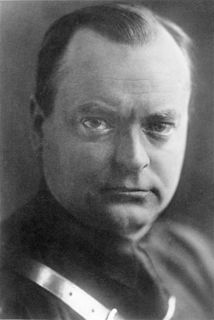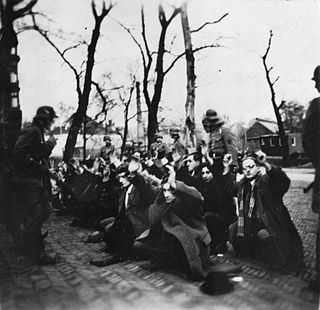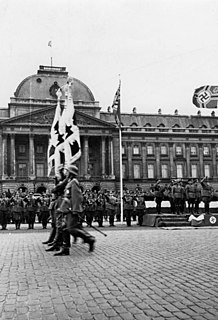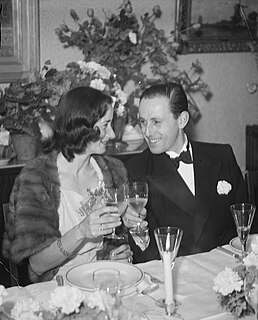
Anton Adriaan Mussert was a Dutch politician who co-founded the National Socialist Movement in the Netherlands (NSB) in 1931 and served as its leader until the party was banned in 1945. As such, he was the most prominent Dutch fascist before and during World War II. Mussert collaborated with the German occupation government, but was granted little actual power and held the nominal title of Leider van het Nederlandse Volk from 1942 onwards. In May 1945, as the war came to an end in Europe, Mussert was captured and arrested by Allied forces. He was charged and convicted of treason, and was executed in 1946.

Despite Dutch neutrality, Nazi Germany invaded the Netherlands on 10 May 1940 as part of Fall Gelb. On 15 May 1940, one day after the bombing of Rotterdam, the Dutch forces surrendered. The Dutch government and the royal family saved themselves by fleeing the country and going to London. Princess Juliana and her children moved on to Canada for additional safety.
Resistance movements during World War II occurred in every occupied country by a variety of means, ranging from non-cooperation to propaganda to hiding crashed pilots and even to outright warfare and the recapturing of towns. In many countries, resistance movements were sometimes also referred to as The Underground.

The history of the Jews in the Netherlands is considered to begin largely in the 16th century, when they began to settle in Amsterdam and other cities. It has continued to the present. Following the occupation of the Netherlands by Nazi Germany in May 1940, the Jewish community was severely persecuted. About 70% of its members were killed by the Nazis in the Holocaust during World War II.
The Estonian resistance movement was an underground movement to resist the occupation of Estonia by Nazi Germany, 1941–1944 during World War II. Due to the unusually benign measures implemented in Estonia by the German occupation authorities, especially in contrast to the preceding harsh Soviet occupation of Estonia (1940–1941), the movement was slower to develop effective tactics on a wide scale than in other occupied countries.

The Dutch resistance to the Nazi occupation of the Netherlands during World War II can be mainly characterized as non-violent. The primary organizers were the Communist Party, churches, and independent groups. Over 300,000 people were hidden from German authorities in the autumn of 1944 by 60,000 to 200,000 illegal landlords and caretakers. These activities were tolerated knowingly by some one million people, including a few individuals among German occupiers and military.

Jewish resistance under Nazi rule took various forms of organized underground activities conducted against German occupation regimes in Europe by Jews during World War II. According to historian Yehuda Bauer, Jewish resistance was defined as actions that were taken against all laws and actions acted by Germans. The term is particularly connected with the Holocaust and includes a multitude of different social responses by those oppressed, as well as both passive and armed resistance conducted by Jews themselves.

The Belgian Resistance collectively refers to the resistance movements opposed to the German occupation of Belgium during World War II. Within Belgium, resistance was fragmented between many separate organizations, divided by region and political stances. The resistance included both men and women from both Walloon and Flemish parts of the country. Aside from sabotage of military infrastructure in the country and assassinations of collaborators, these groups also published large numbers of underground newspapers, gathered intelligence and maintained various escape networks that helped Allied airmen trapped behind enemy lines escape from German-occupied Europe.

The Reichskommissariat Niederlande was the civilian occupation regime set up by Germany in the German-occupied Netherlands during World War II. Its full title was the Reich Commissariat for the Occupied Dutch Territories. The administration was headed by Arthur Seyss-Inquart, formerly the last chancellor of Austria before initiating its annexation by Germany.
Geertruida Elisabeth Middendorp the lady that wore the Jewish star; was a member of the LO (Landelijke Organisatie voor Hulp aan Onderduikers Dutch Resistance. The LO made counterfeit coupons; it also obtained authentic coupons from loyal Netherlands citizens in the employ of the Dutch Nazis. Other groups conducted raids and robberies to steal authentic coupons from government agencies. And some Dutch civilians gave up their own coupons to the LO during the second world war. She married Hendrik Middendorp in 1934

The Deutsche Zeitung in den Niederlanden was a German-language nationwide newspaper based in Amsterdam, which was published during almost the entire occupation of the Netherlands in World War II from June 5, 1940 to May 5, 1945, the day of the German capitulation in the "Fortress Holland". Its objective was to influence the public opinion in the Netherlands, especially the one of the Germans in this country.

German–Dutch relations are diplomatic, military and cultural ties between the bordering nations of Germany and the Netherlands. Relations between the modern states started after Germany became united in 1871. Before that the Netherlands had relations with Prussia and other, smaller German-speaking nations.

The February Strike was a general strike in the German-occupied Netherlands in 1941, during World War II, organized by the then-outlawed Communist Party of the Netherlands in defence of persecuted Dutch Jews and against the anti-Jewish measures and activities of the Nazis in general.

Despite being neutral at the start of World War II, Belgium and its colonial possessions found themselves at war after the country was invaded by German forces on 10 May 1940. After 18 days of fighting in which Belgian forces were pushed back into a small pocket in the north-west of the country, the Belgian military surrendered to the Germans, beginning an occupation that would endure until 1944. The surrender of 28 May was ordered by King Leopold III without the consultation of his government and sparked a political crisis after the war. Despite the capitulation, many Belgians managed to escape to the United Kingdom where they formed a government and army-in-exile on the Allied side.

The German occupation of Belgium during World War II began on 28 May 1940, when the Belgian army surrendered to German forces, and lasted until Belgium's liberation by the Western Allies between September 1944 and February 1945. It was the second time in less than thirty years that Germany had occupied Belgium.

Various kinds of clandestine media emerged under German occupation during World War II. By 1942, Nazi Germany occupied much of continental Europe. The widespread German occupation saw the fall of public media systems in France, Belgium, Poland, Norway, Czechoslovakia, Northern Greece, and the Netherlands. All press systems were put under the ultimate control of Joseph Goebbels, the German Minister of Propaganda.

Jacob Julius Max Nord was a Dutch journalist, writer, and translator. He was one of the main editors of Het Parool, an illegal Dutch newspaper founded during World War II.

During the German occupation of the Channel Islands, there was limited resistance. The islands had a very high number of German soldiers compared to the civilian population, one soldier for every 2-3 civilians, which reduced options; this linked to the severe penalties imposed by the occupiers meant that only forms of non-lethal resistance were used by the population. Even so, over twenty civilians died for resistance against the occupiers.

Ingeborg Luise Wallheimer Kahlenberg was a German-born photographer and member of the Dutch resistance during the Second World War. She was awarded the Resistance Memorial Cross (VHK), by Royal Dutch decree.

The clandestine press of the French Resistance was collectively responsible for printing flyers, broadsheets, newspapers, and even books in secret in France during the German occupation of France in the Second World War. The secret press was used to disseminate the ideas of the French Resistance in cooperation with the Free French, and played an important role in the liberation of France and in the history of French journalism, particularly during the 1944 Freedom of the Press Ordinances.

















